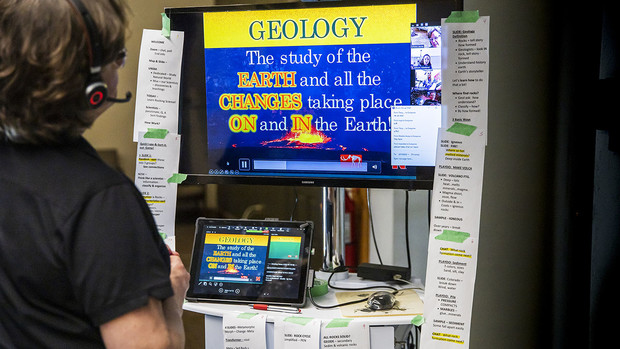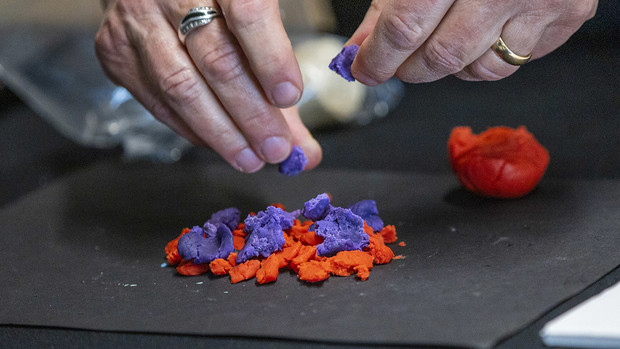University of Nebraska State Museum
Dan Moser, April 22, 2020
Morrill Hall expands online content to meet pandemic challenge
When the coronavirus pandemic shuttered schools and universities last month, the University of Nebraska State Museum was among many museums trying to figure out how to continue carrying out the educational piece of its mission.
Within days, Morrill Hall had some content available remotely for schoolchildren. Within just a few weeks, the museum has built a new library of activities and videos on top of an existing virtual learning effort.
April and May typically are big field trip months for Morrill Hall, with hundreds of students of all ages wandering the exhibits and soaking in lessons, and “it’s kind of heart-wrenching to walk through the museum now and see it empty,” Director Susan Weller said.
In fiscal year 2019, for example, a record 31,000 K-12 students from Nebraska explored the State Museum’s programs.
“Once we knew schools were shutting down … we thought through what we could do to support parents and teachers who are home and trying to support their children’s learning,” Weller said. “That meant taking what we usually do face to face and pivoting to deliver it remotely.”
Emily Brown, the museum’s education supervisor, and her staff, including virtual learning coordinator Annie Mumgaard, got to work.
Mumgaard said the museum began creating virtual field trips about five years ago.
“We started with what we knew best — elephants,” she said.
Eight virtual field trips consisting of standards-based material initially were created.
As the pandemic made in-person visits impossible, Morrill Hall has made its virtual field trips available three times a day every Tuesday in April, which will continue through May. Teachers can sign up their classes, or parents can sign up their children individually. Hundreds of students at a time are participating via Zoom as Nebraska scientists and educators interact live with participants.
Ashfall Fossil Beds, part of the museum, is scheduled to do a program on April 21; a program on evolution is scheduled on April 28. Next month’s offerings scheduled so far are Animals in the Hall, on May 5, and Art of Ancient Sea Monsters, May 12. For more information or to register, click here.
On top of those virtual field trips, museum staff have continued to create online content. Facebook Live learning sessions are posted weekly and archived on the museum’s website; programs so far cover Nebraska fossils, highway paleontology, anthropology preservation and exploring the inland sea. The Mueller Planetarium posts new content exploring space and astronomy every Wednesday. Hands-on activities that require only minimal supplies likely to be available at home are online, as well.
Brown said staff have begun delivering Morrill Hall’s Saturday Investigate programming via live-streaming, too.
Typically, museums have worried that making too much of their content available online could discourage people from visiting the brick-and-mortar buildings. The pandemic is forcing them to rethink this and likely changing their way of doing business for good.
“We talk in the museum world about visitors being able to visit before they physically come to the museum and to return virtually after they’ve left,” Weller said. “What are those different ways that your visitors can continue to learn from the museum?”
The online experience can enrich museums’ contributions as they coordinate it with in-person visits, and the emphasis on home learning “brings us back to our roots, if you will, as observers of nature and of science because your basic tools for doing science are your eyes, your ears, your hands, your nose,” said Weller, who is also a professor of entomology.
“It actually has been a bit liberating,” she said. “It really is allowing good science learning to happen using really the basic, fundamental tools and curiosity. At the end of the day, you remember what you’re curious about. What we’re hoping with this pivot is we’re feeding curiosity and we’re helping nurture that innate wonder, and that’s where your future scientists, your future poets come from.”

Weller said her staff already is thinking beyond this moment to how they can add more museum content online.
“There will be innovation that continues long after this pandemic is gone, and it will be a way for people to connect long after they’re here,” she said.
Mumgaard predicts the museum’s online programming increasingly will be used by teachers to support their classroom curricula by “reinforcing their subject matters, introducing new material and introducing them to new careers and the life of scientists.”
“It just opens up the world,” she said.
She added that Morrill Hall’s embrace of virtual learning is part of a broader transformation of education that will continue from the lessons learned this spring.
“When we exit out of this, the way in which we teach is going to be completely transformed,” said Mumgaard, who is also a member of Lincoln Public Schools’ Board of Education.
While Nebraska remains Morrill Hall’s primary audience, online visits have been noted since the pandemic began from people across the United States, Canada, Italy, Germany, Morocco, Chile, France, Algeria, Turkey, Hong Kong, the Netherlands, Singapore, China, the United Kingdom and South Africa.
“That really gives me goosebumps,” Weller said.
Just as gratifying was this email from a Nebraskan: “Our household in O’Neill visited Morrill Hall in Lincoln three times today … and even got to learn about paleontology with our cousins in Gretna at the same time!”
And Mumgaard recalls a neighbor sending her a picture of his kindergartener following a Morrill Hall virtual field trip online and creating her own scientific illustrations.
“This has been the best half-hour of her day,” he told her.






